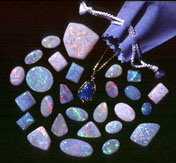What is opal? Where does opal form? What causes the colours in opal? What is potch? How does opal form?
Opal, a precious gemstone of exceptional allure, holds a prominent place in the world of minerals. But what exactly is opal, and where does it originate? Found predominantly in Australia, opal proudly stands alongside diamonds, rubies, sapphires, emeralds, and pearls as one of the six globally recognized precious gemstones. Australia takes the lead, contributing over 90% of the world’s precious opal supply and proudly designating opal as its national gemstone.
Varieties of Opals: What Sets Them Apart?
Delving deeper into opals, you’ll discover a world of variety. Precious opal and common opal, or potch, are two main categories. But what distinguishes these opal varieties? Precious opals are renowned for their captivating play-of-colour, a rarity that enchants onlookers. In contrast, common opal lacks this play-of-colour and appears less vibrant. Commonly known as potch, it is abundant worldwide. When precious opal intertwines with common opal, it takes on the name potch. Astoundingly, around 95% of mined opals belong to the common or potch category, reflecting a single hue such as white, grey, or black – primarily used as backing for doublets or triplets. Merely about 5% showcase colours, with only 0.25% boasting substantial value.
The Science Behind Opal’s Magic: How Does It Work?
The scientific makeup of opal, referred to as SiO2·nH2O, unveils the secrets behind its enchanting play-of-colour. Comprising hydrated silicon dioxide, a fusion of silica and water, opal’s appearance spans from colourless to dark grey and black. Yet, opal’s true enchantment arises from its play-of-colour, a dance of light within minuscule silica spheres embedded within the opal’s structure. This intricate interplay gives rise to a breathtaking kaleidoscope of rainbow hues, transforming as you change your viewing angle.
Decoding Opal’s Nature: What Defines It?
Opal, a crystalline gem mineral, takes form through the solidification of gelatinous or liquid silica within cracks and voids, often created by decaying organic matter, wood, crustaceans, and bones. Its highest value resides in its “black” forms, embodying a significant water content. Represented by SiO2 plus H2O, opals can encompass up to 10% water content, boasting a refractive index that ranges from 1.38 to 1.60. On the Mohs’ scale, opals register a hardness of 5.5 to 6.5.
The Saga of Precious Opal: How Does It Emerge?
“Precious opal” signifies opaline silica displaying an enchanting play-of-colour. Australian opals, often termed “sedimentary opal,” primarily reside within sedimentary rocks of the Mesozoic Great Artesian Basin. Typically containing 5-6% water, these opals are composed of tiny, well-ordered silica spheres. Their hardness, ranging from 5.5 to 6.5 on the Mohs’ scale, aligns closely with that of glass.
The Birth of Opal: How Does It Form?
Opal’s formation is a captivating journey, beginning with the fusion of silicon dioxide and water. As water infiltrates sandstone, it collects minuscule silica particles. Millions of years ago, this solution seeped into crevices in both sedimentary and volcanic regions across inland Australia. Over millennia, deposition sculpted the opal’s destiny – approximately a centimetre every five million years at a depth of forty metres. Over 1 to 2 million years, solidification ensued, intertwined with shifting climates. The opal’s narrative spans soft phases before eventual solidification.
Opal’s Chromatic Symphony: What Creates Its Colours?
As the solution infused with silica deposited and water content lessened, silica particles clustered to form spheres within the gel. These spheres fused, crafting structures of amorphous silica ranging from 1500 to 3500 angstroms. Like marbles nestled together, they left delicate voids. This meticulous arrangement turned opal into an optical diffraction grating, refracting visible light into its full spectrum of colours. Sphere size dictated the emitted hue, with larger spheres yielding red or orange, and smaller ones radiating blue.
Valuing Opal: How Is Its Worth Determined?
The value of each opal is a masterpiece woven from its distinct traits: body tone, play-of-colour, brilliance, pattern, type and size. Amid the opal expanse, individuality reigns supreme, with each gem reflecting a unique symphony of traits that defines its worth.
Embark on an opal odyssey, where nature’s marvels intertwine with scientific wonders, beckoning you to unravel the captivating beauty of these gemstones.
Click here to download the pdf of the Opal Body Tone and Patterns Chart (courtesy of Opal Association – www.opal.asn.au)
Sources :
- “Opal in South Australia”, Mines & Energy Resources, SA
- “Opal”, Qld Dept. of Mines & Energy
- “Black Opal: A comprehensive guide to cutting and orientation”, by Greg Pardey, GP Creations, 1999.
- “Opals”, by Fred Ward, Gem Book Publishers, 1997.


